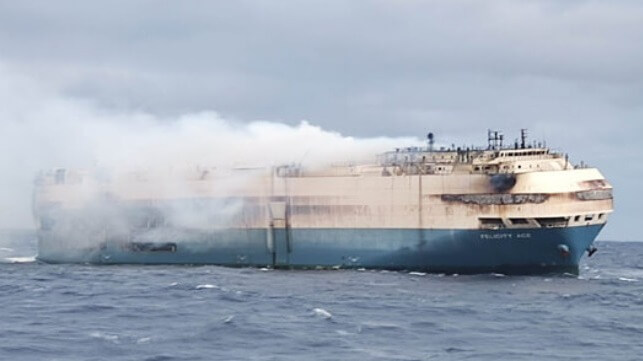MOL is Deploying AI System for Early Fire Detection on New Car Carriers

Japan’s Mitsui O.S.K. Lines will be deploying an AI-based system developed by an Israeli startup in its efforts to improve fire safety aboard the company’s car carriers. The dangers of fire at sea are well-known while remaining one of the leading casualties. The industry is seeking new solutions to address the dangers of runaway fires, especially from EVs and lithium-ion batteries.
All of MOL’s car carriers are currently equipped with fire alarms primarily based on smoke detectors. Companies have taken steps to increase the fire precautions but still, there have been catastrophic losses. MOL suffered one such casualty in February 2022 when its vessel the Felicity Ace caught fire about 90 nautical miles to the southwest of Faial, an island in the center of the Azores. The vessel was evacuated and the fire burned for days before the ship was lost. The ship was carrying roughly 4,000 cars, including Lamborghinis, Audis, and Volkswagens, with estimates that the financial loss would exceed $400 million.
While the cause of the fire was never established and EV manufacturers contend that their vehicles pose no greater risk, battery fires present a unique set of challenges. They burn hotter and quickly become runaway events that are nearly impossible to stop. Weeks after the fire on another car carrier, the Fremantle Highway earlier this year, one of the EVs salvaged from the ship was still soldering when it was brought off the ship requiring a dousing method to extinguish the fire.
MOL reports that it will install an AI system developed by Israeli company Captain’s Eye on 10 new LNG-fueled car carriers that it currently has on order. The ships will begin to enter service in 2024 and they are also considering retrofitting the system to in-service vessels. MOL’s March 2023 report showed that it currently has 96 car carriers and plans to grow to as many as 120 vessels in the segment.
They report that they have conducted demonstration tests with Captain’s Eye to explore the AI system's smoke detection capabilities of the system. Captain's Eye AI systems are already used to detect abnormalities in the engine room and on deck and have been introduced on merchant ships and other vessels including yachts around the world.
Using cameras in cargo holds aboard the car carrier Onyx Ace, an 18,500 dwt pure vehicle carrier introduced in 2012. It has a capacity for approximately 6,500 vehicles. In collaboration with Captain's Eye, MOL says that it has improved the system's functionality through multiple tests, and has confirmed its effectiveness, including the successful detection of small amounts of smoke.
The system will analyze images from cameras that will be installed around the car decks of the vessel. When it detects abnormalities in the images, the system sends an alert to crewmembers both aboard the vessel and to the onshore ship management team. MOL believes the system will enable faster smoke detection and that the images will help the team on the ship and shore to respond quicker and manage fire dangers.
Insurance giant Allianz issued a market analysis report earlier this year citing fires as one of the continuing dangers for the maritime industry and its insurers while highlighting the expectation that the battery market will grow by over 30 percent annually over the next decade. They calculated that there were over 200 fires reported in 2022, the highest number for a decade. Fire incidents Allianz said were up 17 percent in 2022 and they were the third most common cause of incidents globally. Over the past five years, they reported 64 ships were total losses due to the fire.
MOL Group noted that it is continuing to pursue advanced fire prevention measures in the cargo areas on its car carriers. The AI system they believe will provide another tool for earlier detection of potential dangers and responses from their crews before the incident has time to grow into a potentially catastrophic loss.
